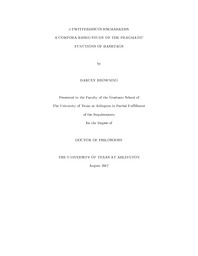
ATTENTION: The works hosted here are being migrated to a new repository that will consolidate resources, improve discoverability, and better show UTA's research impact on the global community. We will update authors as the migration progresses. Please see MavMatrix for more information.
Show simple item record
| dc.contributor.advisor | Stvan, Laurel Smith | |
| dc.creator | Browning, Darcey Nicole | |
| dc.date.accessioned | 2017-10-02T14:53:41Z | |
| dc.date.available | 2017-10-02T14:53:41Z | |
| dc.date.created | 2017-08 | |
| dc.date.issued | 2017-08-11 | |
| dc.date.submitted | August 2017 | |
| dc.identifier.uri | http://hdl.handle.net/10106/26992 | |
| dc.description.abstract | In this dissertation, I posit that hashtags can function as discourse markers, where space constraints of 140 characters on Twitter complicate their realization. Through the progression of research questions that shape each chapter, this dissertation analyzes how hashtags assist with felicitous communication to the intended audience of a tweet via four distinct corpora.
The first function of discourse markers investigated in this dissertation involves delays; in emotional narratives, we would expect to find discourse markers acting as delays. Starting with a corpus of survivor interviews, I investigate which traditional discourse markers appear frequently when survivors talk about violence and which content environments seem to prompt traditional, spoken discourse markers in these emotional narratives. Following up on the spoken discourse markers, I found similar patterns in survivor tweets from the #whyIstayed campaign. Using a corpus of 443 survivor tweets from across 73 days, I show how the initial placement of some hashtags before sensitive information can be a delay device. I also explore what linguistic content is more likely to cause this tweet-initial placement through statistical evidence, showing similarities between the hashtags and traditional discourse markers. Through answering the research questions for Chapter 2 and 3, I show how hashtags are act as delays in a similar fashion to some spoken DMs.
The second discourse marker function investigated in this dissertation is clarification. Starting with a general corpus of 1791 tweets from 2012, I explore the different functions of hashtags, finding that over 75% of hashtags in this corpus are involved with clarifying tweet content. Using the heuristics presented in Clark and Marshall (1981), I investigate how some hashtags can clarify the meaning of the tweet, through what I call tag reframing hashtags in Chapter 4. The third function is to reveal speaker’s attitude, and in Chapter 5, I look at how two very different attitudes are expressed through the use of #NastyWoman. Using tag reframing hashtags in conjunction with a learning algorithm, I was able to analyze a second corpus of over 55,000 tweets from the 2016 presidential election to show the reclamation of a pejorative in Chapter 5. I show through the density of pejorative and reclaimed uses of #NastyWoman the power struggle in the use of this term at the associated attitudes in the 18 days before the election.
Using a progression of corpus collection methods and data management, this dissertation shows that some hashtags are discourse markers, indicating that hashtags in computer mediated language pattern in form and function as discourse markers in other language genres do. | |
| dc.format.mimetype | application/pdf | |
| dc.language.iso | en_US | |
| dc.subject | Hashtag | |
| dc.subject | Discourse markers | |
| dc.subject | Computer mediated language | |
| dc.subject | Pragmatics | |
| dc.subject | #NastyWoman | |
| dc.subject | Elections | |
| dc.subject | #WhyIStayed | |
| dc.subject | Repair | |
| dc.subject | Corpus linguistics | |
| dc.title | #TWITTERDISCOURSEMARKERS: A CORPORA BASED STUDY OF THE PRAGMATIC FUNCTIONS OF HASHTAGS | |
| dc.type | Thesis | |
| dc.degree.department | Linguistics | |
| dc.degree.name | Doctor of Philosophy in Linguistics | |
| dc.date.updated | 2017-10-02T14:54:44Z | |
| thesis.degree.department | Linguistics | |
| thesis.degree.grantor | The University of Texas at Arlington | |
| thesis.degree.level | Doctoral | |
| thesis.degree.name | Doctor of Philosophy in Linguistics | |
| dc.type.material | text | |
Files in this item
- Name:
- BROWNING-DISSERTATION-2017.pdf
- Size:
- 3.140Mb
- Format:
- PDF
This item appears in the following Collection(s)
Show simple item record


